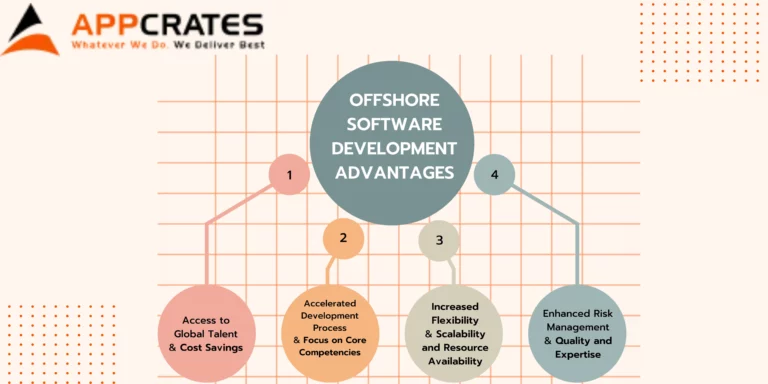Offshore Software Development Trends
Introduction
Offshore software development trends has become an integral part of the global IT industry. It offers numerous benefits, including cost savings, access to a larger talent pool, and accelerated development timelines. In this article, we will explore the latest trends in offshore software development and how they are shaping the industry. From emerging technologies to agile methodologies, we will delve into the key factors driving the success of offshore software development projects.
Rise of Remote Collaboration
As technology continues to advance, remote collaboration tools and platforms have become more robust and accessible. Offshore software development teams can now work seamlessly with clients and stakeholders from different locations. Real-time communication, video conferencing, and project management tools have made it easier to bridge the geographical gap, resulting in increased efficiency and productivity.
Adoption of Agile Methodologies
Agile methodologies, such as Scrum and Kanban, have gained significant popularity in the software development industry. Offshore development teams are increasingly embracing agile practices to enhance project visibility, collaboration, and flexibility. Agile development methodologies enable iterative and incremental development, allowing for faster delivery of high-quality software.
Focus on Security and Data Protection
With the rising number of cyber threats, data breaches, and privacy concerns, security has become a top priority for offshore software development. Offshore teams are implementing robust security measures and following industry best practices to ensure the protection of sensitive data. Compliance with data protection regulations, such as GDPR, is also crucial for maintaining trust and credibility.
Cloud Computing and DevOps Integration
Cloud computing has revolutionized the way software is developed, deployed, and scaled. Offshore development teams are leveraging cloud platforms, such as Amazon Web Services (AWS) and Microsoft Azure, to build scalable and resilient applications. Integration of DevOps practices further enhances collaboration and streamlines the software development lifecycle.
Artificial Intelligence and Machine Learning
Artificial Intelligence (AI) and Machine Learning (ML) are transforming various industries, including software development. Offshore teams are utilizing AI and ML technologies to automate repetitive tasks, enhance software testing processes, and improve data analysis. AI-powered chatbots and virtual assistants are also being integrated into software applications to enhance user experience.
Internet of Things (IoT) Development
The Internet of Things (IoT) has opened up new possibilities for offshore software development. Offshore teams are working on IoT projects to build smart and connected solutions. From home automation to industrial monitoring, IoT development is enabling businesses to gather and analyze real-time data, leading to improved operational efficiency and decision-making.
Microservices Architecture
Microservices architecture has gained traction in offshore software development due to its flexibility and scalability. Offshore teams are breaking down monolithic applications into smaller, independent services that can be developed and deployed individually. Microservices architecture enables faster development, easier maintenance, and better fault tolerance.
Enhanced User Experience (UX) Design
User experience (UX) design plays a crucial role in the success of software applications. Offshore development teams are investing in UX research and design to create intuitive and user-friendly interfaces. Usability testing and user feedback are incorporated throughout the development process to ensure that the final product meets the expectations and needs of end-users.
Blockchain Integration
Blockchain technology is revolutionizing industries such as finance, supply chain, and healthcare. Offshore software development teams are exploring blockchain integration to enhance security, transparency, and traceability in various applications. From decentralized finance to smart contracts, blockchain offers a myriad of opportunities for offshore development projects.
Continuous Integration and Delivery (CI/CD)
Continuous Integration and Delivery (CI/CD) practices have become essential for agile software development. Offshore teams are implementing CI/CD pipelines to automate the build, test, and deployment processes. Continuous integration ensures that code changes are regularly merged and tested, while continuous delivery enables frequent and reliable software releases.
Nearshore Outsourcing
In addition to offshore outsourcing, nearshore outsourcing is gaining popularity in the software development industry. Nearshore teams are located in neighboring countries or regions, allowing for closer time zones and cultural affinity. Nearshore outsourcing offers advantages such as easier collaboration, reduced travel costs, and better alignment of business practices.
Importance of Cultural Compatibility
Cultural compatibility is crucial when working with offshore software development teams. Understanding cultural differences, communication styles, and work ethics helps foster effective collaboration and minimize misunderstandings. Offshore teams that prioritize cultural compatibility create a harmonious working environment and deliver successful software projects.
Rise of Hybrid Development Models
Hybrid development models are emerging as a preferred approach for offshore software development. These models combine the advantages of both onsite and offshore teams, striking a balance between cost-effectiveness and close collaboration. Hybrid models allow organizations to leverage local talent while benefiting from the scalability and cost savings offered by offshore teams.
Conclusion
Offshore software development continues to evolve, driven by advancements in technology and changing market dynamics. The trends discussed in this article, from remote collaboration to hybrid development models, highlight the industry’s focus on innovation, efficiency, and customer-centricity. By staying abreast of these trends, organizations can leverage offshore development to achieve their software development goals effectively.
FAQs
What is offshore software development?
Offshore software development refers to the practice of outsourcing software development tasks to teams located in different countries or regions, often with cost and talent advantages.
What are the advantages of offshore software development?
Offshore software development offers benefits such as cost savings, access to a larger talent pool, faster development timelines, and flexibility in scaling resources.
How do offshore teams ensure data security?
Offshore teams prioritize data security by implementing robust security measures, following industry best practices, and complying with data protection regulations.
What is the role of agile methodologies in offshore software development?
Agile methodologies enable offshore teams to enhance collaboration, visibility, and flexibility in software development projects, resulting in faster delivery of high-quality software.
What is the difference between offshore and nearshore outsourcing?
Offshore outsourcing involves working with teams located in different countries, while nearshore outsourcing involves collaborating with teams in neighboring countries or regions, offering closer time zones and cultural affinity.








